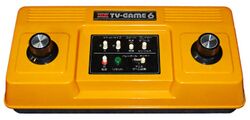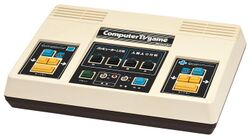Software:Nintendo arcade machines
Nintendo released a series of arcade games in the 1970s and 80s. The company made toys and trading card games prior to their film projection-based light gun games from 1973 to 1978. Nintendo released its first electronic arcade game in 1978, an adaptation of the board game Reversi. Many of Nintendo's first video games were knockoffs, or "clones", of existing games with slight variations, including Breakout clones and clones of Space Invaders and Galaga. Nintendo also successfully released its first Japanese home consoles, the Color TV series, which brought arcade games to personal televisions.
History
Nintendo primarily made toys and trading card games before their arcade games in the mid-1970s. Most of their later releases between 1973 and 1978 were light gun games based on shooting or avoiding things. The cabinets used pre-recorded images and film projection rather than video inside.[1]
The company's first electronic video game was an adaptation of the board game Reversi, released in 1978.[1] Many of Nintendo's first coin-operated, electronic arcade games were slight variations on existing games, known as knockoffs or clones.[1][2] Later in 1978, Nintendo released a Breakout clone, based on the popular arcade game. The company's most famous arcade games would be Donkey Kong (1981) and Mario Bros. (1983).[1]
Many of Nintendo's games were also released for their Japan-only Color TV home console series, which played arcade games on home televisions.[1] Nintendo's first series of home consoles was commercially successful.[3]
Games
Computer Othello (June 1978[4]) is a clone of the board game Reversi. It was the first game produced by Nintendo R&D1, the team that later produced the first Mario, Donkey Kong, Duck Hunt, and Kid Icarus games. R&D1 was led by Gunpei Yokoi, who later created the Game Boy, and included Mario and Legend of Zelda creator Shigeru Miyamoto.[1]
Block Fever (November 1978[4]) is a clone of Breakout.[1]
Space Fever (February 1979[4]) is a clone of Space Invaders, as was its sequel, SF-HiSplitter.[1]
Head On N (1979) is an overhead-view racing game. The game is identical to Sega's Head On 2, which Nintendo licensed and renamed.[2] Luke Plunkett of Kotaku described the game as a Pac-Man clone, despite being released a year prior.[1] Jeremy Parish of USGamer wrote that the game's existence had little justification.[2]
Monkey Magic (August 1979[4]) is another Breakout clone: the player uses a paddle to hit a ball and break apart bricks organized in the shape of the Monkey King's face. Regenerating blocks was its innovation on the popular Breakout formula. The game was not published outside Japan.[2]
Sheriff (October 1979[4])
Radar Scope (December 1979)
HeliFire (1980) is a clone of Space Invaders where the player moves a submarine instead of spacecraft. Enemies attack the submarine from the top and bottom of the screen.[2]
Space Firebird (1980)
Donkey Kong (August 1981[4]) ... It was designed by Miyamoto and introduced Mario (then known as "Jumpman"). Donkey Kong was a progenitor of the platformer genre, among the first games with narrative elements, and Nintendo's most successful arcade game.[4]
Sky Skipper (1981) is a game in which the player controls a biplane to save captured animals that are guarded by large monkeys. The game was only released in Japan, but North America received a port by Parker Brothers for the Atari 2600. Parish (USGamer) described the game as Nintendo attempting to replicate Donkey Kong's popularity and mistakenly focusing on the prominence of the monkey.[2]
Space Demon (1981) is the successor to Space Firebird, both Galaga clones with very similar gameplay. The two releases were not successful.[2]
Arm Wrestling (1985) is an arm wrestling game. It uses two monitors, similar to Punch-Out!! Parish (USGamer) reported that the game's graphics and gameplay were too difficult to transition to console games, unlike Punch-Out!!'s rhythm-based play. Parish recommended purchasing an inexpensive arcade cabinet as a novelty.[2]
Legacy
Nintendo has reused their assets in their "nostalgia-driven" projects such as WarioWare and Super Smash Bros.[2]
References
- ↑ 1.0 1.1 1.2 1.3 1.4 1.5 1.6 1.7 1.8 Plunkett, Luke (April 21, 2011). "Nintendo's First Arcade Games Were, Well, Pretty Sucky". Kotaku. Gawker Media. Archived from the original on July 27, 2015. https://www.webcitation.org/6aK96MxGc?url=http://kotaku.com/5794203/nintendos-first-arcade-games-were-well-pretty-sucky. Retrieved July 26, 2015.
- ↑ 2.0 2.1 2.2 2.3 2.4 2.5 2.6 2.7 2.8 Parish, Jeremy (July 25, 2014). "Forgottendo: 10 Nintendo Games You've Probably Never Heard Of". USGamer. Gamer Network. Archived from the original on July 27, 2015. https://www.webcitation.org/6aK5rk93s?url=http://www.usgamer.net/articles/forgottendo-10-nintendo-games-youve-probably-never-heard-of. Retrieved July 26, 2015.
- ↑ Plunkett, Luke (March 25, 2011). "Nintendo's First Console Is One You've Never Played". Kotaku. Gawker Media. Archived from the original on July 27, 2015. https://www.webcitation.org/6aKCIMT7s?url=http://kotaku.com/5785568/nintendos-first-console-is-one-youve-never-played. Retrieved July 26, 2015.
- ↑ 4.0 4.1 4.2 4.3 4.4 4.5 4.6 Picard, Martin (December 2013). "The Foundation of Geemu: A Brief History of Early Japanese video games". Game Studies. Archived from the original on July 27, 2015. https://www.webcitation.org/6aKKMVgsG?url=http://gamestudies.org/1302/articles/picard. Retrieved July 27, 2015.
- Ryan, Jeff (2011). Super Mario: How Nintendo Conquered America. Penguin. ISBN 978-1-101-51763-5. https://books.google.com/books?id=1k-6ksl3uLsC&pg=PT208.



